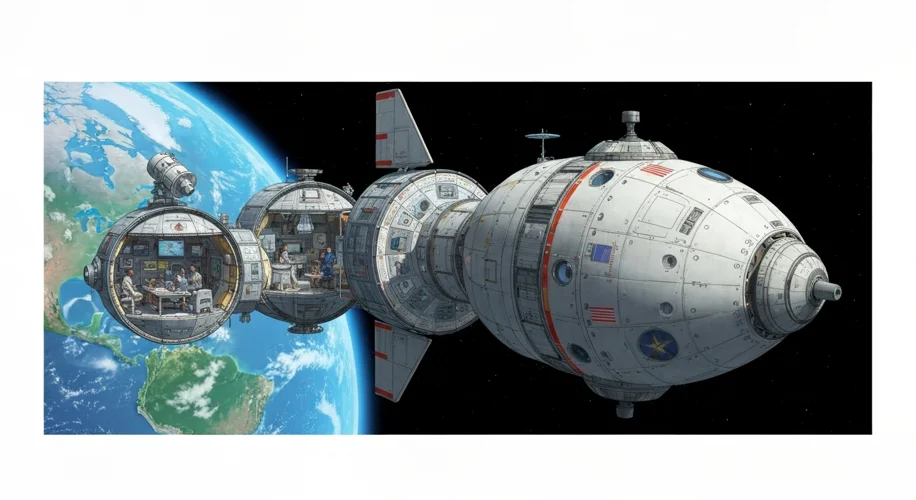The roar of the Saturn V rocket has become synonymous with humanity’s giant leap onto the Moon, a testament to the audacious Apollo program. Yet, before the thunderous ascent of Apollo, a more experimental, yet equally ambitious, era of space exploration unfolded: Project Gemini. Designed as a crucial bridge between the suborbital flights of Project Mercury and the lunar aspirations of Apollo, Gemini pushed the boundaries of human capability in orbit. But what if some of Gemini’s most forward-thinking concepts had been fully realized? What if NASA had pursued the daring ‘what-ifs’ conceived during those formative years?
Project Gemini, spanning from 1965 to 1966, was a period of intense innovation and learning. Astronauts spent longer in space than ever before, practiced rendezvous and docking maneuvers – essential for lunar missions – and conducted spacewalks, or Extravehicular Activities (EVAs). However, beyond the missions that actually flew, a universe of advanced concepts lay on the drawing boards, concepts that, if implemented, could have dramatically accelerated humanity’s journey into the cosmos.
One of the most tantalizing ‘what-ifs’ centers on the idea of a Gemini Orbital Workshop. While the Skylab program later delivered a space station, early Gemini planning included concepts for a permanently crewed orbital laboratory. Imagine a Gemini capsule, modified and refitted, serving as a nucleus for a larger, modular space station. This wasn’t just a fleeting thought; proposals involved using multiple Gemini launches to dock together, creating a more spacious and capable research platform. Such a station could have been operational years before Skylab, providing invaluable long-term data on human adaptation to space and offering a more robust platform for early astronomical observations and materials science experiments. The challenges were significant – extending the duration of Gemini missions and developing life support for longer stays – but the potential rewards, in terms of scientific return and operational experience, were immense.

Another groundbreaking concept was the Gemini Lunar Flyby Mission. Before the commitment to a lunar landing, NASA seriously considered a Gemini mission that would swing around the Moon and return to Earth. This would have been a monumental undertaking, requiring a more powerful propulsion system for the Gemini spacecraft than originally designed, and pushing the limits of navigation and communication over vast distances. Such a mission, potentially launched in late 1967 or early 1968, could have provided critical reconnaissance of potential landing sites and invaluable experience in translunar coasting and navigation. It would have been a daring precursor to Apollo, offering a taste of lunar proximity without the immediate risks of a landing. The sheer audacity of the plan, however, likely contributed to its shelving in favor of the more direct lunar landing approach, which, while riskier, offered a clearer path to the political objective of reaching the Moon first.
Furthermore, Gemini explored advanced rendezvous and docking techniques that went far beyond the successful docking maneuvers seen in the actual missions. Concepts included the use of multiple rendezvous maneuvers to achieve precise orbital positioning and more complex docking procedures for larger payloads. Some proposals even envisioned using the Gemini capsule as a ‘tugboat’ to move larger orbital structures. These ideas were born out of a need to develop versatile capabilities for assembling larger spacecraft in orbit, a skill set that would prove essential for future missions, including the construction of the International Space Station decades later.
What might have happened if the Gemini program had embraced these bolder visions? A Gemini Orbital Workshop could have given the U.S. a significant head start in establishing a continuous human presence in space, potentially influencing the trajectory of subsequent space station development. A lunar flyby mission would have offered invaluable early data and psychological preparation for the Moon landings, perhaps even paving the way for more ambitious lunar exploration in the immediate post-Apollo era.
The decision to focus on the lunar landing was, of course, driven by the geopolitical imperative of the Space Race. The urgency to beat the Soviet Union to the Moon demanded a streamlined, focused approach. Yet, history is replete with ‘what-ifs,’ and the advanced concepts of Project Gemini represent a fascinating glimpse into a slightly different, perhaps even more accelerated, path of space exploration. These unrealized dreams remind us that innovation often thrives on the edge of possibility, and that even in the most successful programs, there are always frontiers left to explore, waiting for the next generation of visionaries to pick up the torch.

